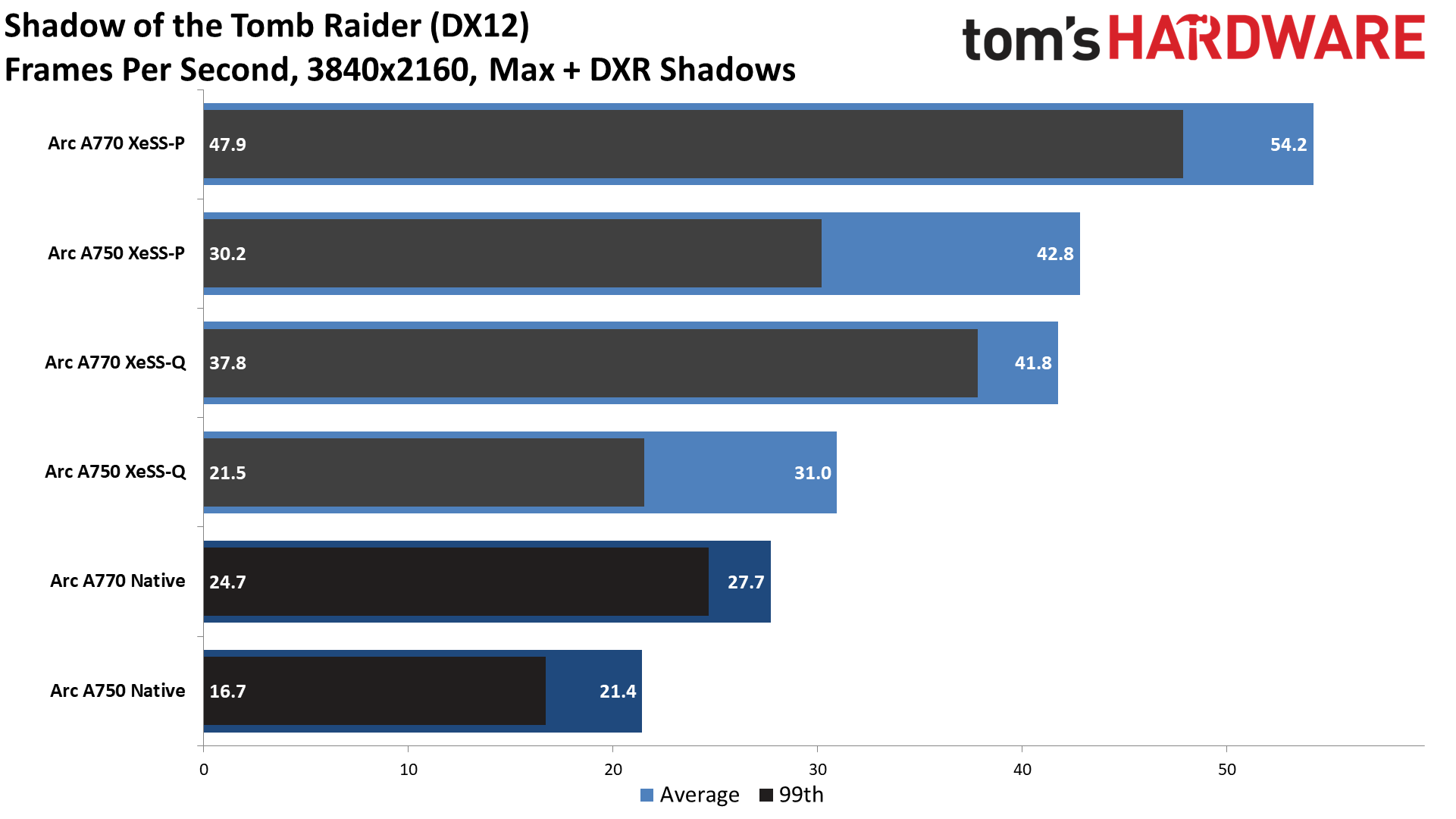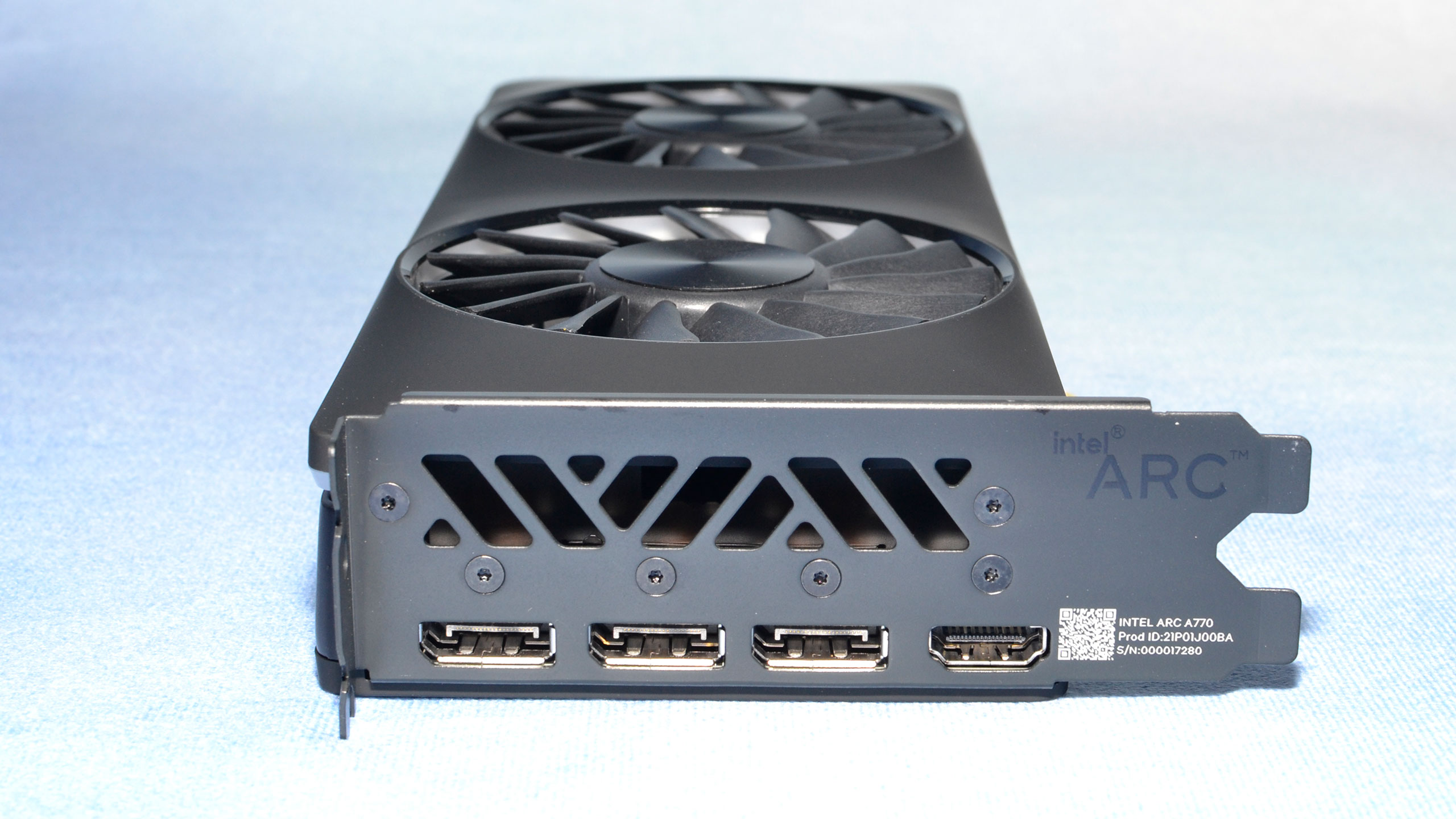Why you can trust Tom's Hardware
Intel Arc A770 XeSS Performance and Quality
XeSS has been heralded as a more open alternative to Nvidia's DLSS. Both use machine learning to train an AI network that will then intelligently upscale and anti-alias lower resolution input frames into a higher resolution result. Both should improve over time as the network and algorithms get tweaked. In theory, it seems as though XeSS should be able to match DLSS 2 quality — but doing something more involved like DLSS 3 would be another matter.
Right now, we have a few publicly available games: Shadow of the Tomb Raider, Monster Hunter Rise, Death Stranding, and… I'm not sure which of the others are actually out. You can check Intel's XeSS page for further updates, but Intel also provided beta access to XeSS in Hitman III, The DioField Chronicle, Ghostwire Tokyo, and Arcadegeddon. Unfortunately, we didn't have time to test all of those, so we just did some testing with Shadow of the Tomb Raider and Death Stranding.
One thing you need to understand with XeSS is that it has support for both Intel's XMX cores, but for non-Arc GPUs, it can utilize DP4a instructions (basically 8-bit integers). Here's the kicker: The two algorithms are not the same! That makes sense, as the XMX cores provide far more computational power than any GPU using DP4a, so the quality will inevitably be lower with DP4a mode. And DP4a is what you'll get on any non-Arc GPU for now.
It's also important to note that even in XMX mode, on a significantly slower GPU like the Arc A380, XeSS may not show as much of a benefit. Instead, it's probably running into bottlenecks of some form, or at least that's what it looked like in our testing last week. Anyway, we'll have to wait and see how the adoption and quality of XeSS changes over time, but there's still AMD's FRS 2 (now 2.1), which tends to work much faster than XeSS DP4a mode while potentially providing equal or better image quality. That's okay since Arc can run FSR2 just fine, but it does make it more difficult to get developer buy-in for XeSS.






Due to time constraints, we've only tested the A770 and A750 cards in two games, using native, Quality, and Performance modes — at three resolutions. Quality looks relatively close to native, while Performance mode uses 4X upscaling and can definitely look worse than native (for now, anyway).
Quality mode, which likely uses 2X upscaling (if it's the same as DLSS and FSR2), improves performance by up to 28% in Death Stranding, but we're clearly hitting CPU bottlenecks as the gains are far lower at 1440p and non-existent at 1080p.
The gains are more pronounced for Shadow of the Tomb Raider, with maxed-out settings including ray-traced shadows. The A750 sees up to a 44% improvement at 4K but very little change at 1080p. Interestingly, the A770 improves by 51% at 4K and 18% at 1080p. There does appear to be some impact due to the reduced amount of VRAM on the A750, though it may also be driver related.
Performance mode helps even more, as you'd expect. In Death Stranding, 1080p remains CPU bottlenecked, but 4K performance improves by 53% while 1440p gains 20–26%. On the other hand, Tomb Raider performance basically doubles at 4K, increases by 45–55% at 1440p, and is 25–35% faster at 1080p.
Those are far bigger gains than when we tested Shadow of the Tomb Raider XeSS on a collection of GPUs that didn't include Arc A700-series parts. Again, DP4a might be okay in a pinch if no other upscaling algorithm is available, but it's not all that great for now.
Intel Arc A770 Video Encoding Performance and Quality
One of the bigger selling points for the Arc A770, and Intel's Arc Alchemist GPUs in general, is the support for hardware accelerated AV1 and VP9 video encoding. Current AMD and Nvidia GPUs only support hybrid decoding of VP9 and AV1, where some of the work is done by the CPU, and both codecs can prove quite taxing on lesser CPUs. Ada and RDNA 3 will add AV1 support, but those will likely start with high-end and extreme performance (and price) cards, not midrange options that cost less than $350.
We extensively tested the Arc A380 video encoding performance and quality, and things should be effectively unchanged with Arc A770 and A750 as the video engine is a fixed functional unit — all the extra Xe-Cores don't matter. If you're interested in learning more about Arc's video engine and encoding quality, we refer you to the previous article for now. The summary is that Arc GPUs could be great for streaming AV1 once support for that codec becomes more widely available.
- MORE: Best Graphics Cards
- MORE: GPU Benchmarks and Hierarchy
- MORE: All Graphics Content
Get Tom's Hardware's best news and in-depth reviews, straight to your inbox.
Current page: Intel Arc XeSS and Video Encoding
Prev Page Intel Arc A770 Ray Tracing Performance Next Page Intel Arc A770: Power, Temps, Noise, Etc.
Jarred Walton is a senior editor at Tom's Hardware focusing on everything GPU. He has been working as a tech journalist since 2004, writing for AnandTech, Maximum PC, and PC Gamer. From the first S3 Virge '3D decelerators' to today's GPUs, Jarred keeps up with all the latest graphics trends and is the one to ask about game performance.
-
ingtar33 When Intel can deliver drivers that don't crash simply opening a game i might be interested; however until the software side is figured out (something intel hasn't done yet in 20+ years of graphic drivers) I simply can't take this seriously.Reply -
edzieba If you're getting a headache with all the nebulously-pronounceable Xe-ness (Xe-cores, Xe Matrix Engines, Xe kitchen sink...) imagine it is pronounced "Ze" in a thick Hollywood-German accent. Much more enjoyable.Reply -
I'd like to see benchmarks cappped at 60fps. Not everyone uses high refresh rate monitor and today, when electricity is expensive and most likely will be even more in the near future, I'd like to see how much power a GPU draws when not trying to run the game as fast as possible.Reply
-
AndrewJacksonZA FINALLY, Intel is back! Or at least, halfway back. It's good seeing them compete in this midrange, and I hope that they flourish into the future.Reply
And I really want an A770, my i740 is feeling lonely in my collection. ;-) -
AndrewJacksonZA Reply
The "EKS-E" makes it sound cool!edzieba said:If you're getting a headache with all the nebulously-pronounceable Xe-ness (Xe-cores, Xe Matrix Engines, Xe kitchen sink...) imagine it is pronounced "Ze" in a thick Hollywood-German accent. Much more enjoyable.
-
-Fran- Limited Edition? More like DoA Edition...Reply
Still, I'll get one. We need a strong 3rd player in the market.
I hope AV1 enc/dec works! x'D!
EDIT: A few things I forgot to mention... I love the design of it. It's a really nice looking card and I definitely appreciate the 2 slot, not obnoxiously tall height as well. And I hope they can work as secondary cards in a system without many driver issues... I hope... I doubt many have tested these as secondary cards.
Regards. -
LolaGT The hardware is impressive. It looks the part, in fact that looks elegant powered up.Reply
It does look like they are trying to push out fixes, unfortunately when you are swamped with working on fixes optimization takes a back seat. The fact that they have pushed out quite a few driver updates shows they are spending resources on that and if they keep at that.....we'll see. -
AndrewJacksonZA Reply
Same. I have a BOATLOAD of media that I want to convert and rip to AV1, and my i7-6700 non-K feels sloooooowwww, lol.-Fran- said:I hope AV1 enc/dec works! -
rluker5 Looks like this card works best for those that want to max out their graphics settings at 60 fps. Definitely lagging the other two in driver CPU assistance.Reply
And a bit of unfortunate timing given the market discounts in AMD gpu prices. The 6600XT for example launched at AMD's intended price of $379. The A770 likely had it's price reduced to account for this, but the more competitors you have, generally the more competition you will have.
I wonder how many games the A770 will run at 4k60 medium settings but high textures? That's what I generally play at, even with my 3080 since the loss in visual quality is worth it to reduce fan noise.

